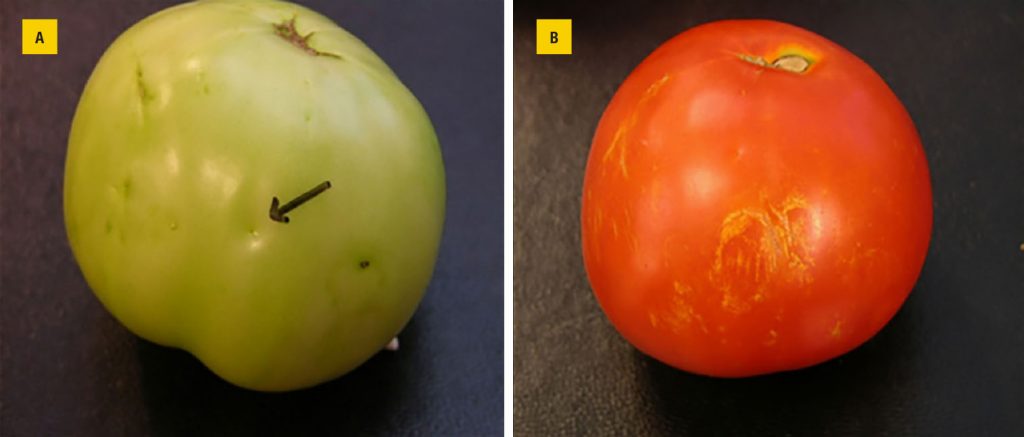
By Xavier Martini and Joe Funderburk
Thrips are important pests of tomatoes for two reasons. First, they damage fruit directly by egg-laying or feeding (Figure 1). More importantly, some species also vector tospoviruses that include tomato spotted wilt virus, groundnut ringspot virus and tomato chlorotic spot virus.
These tospoviruses can considerably decrease the crop yield if thrips are not controlled. Thrips acquire tospoviruses during the nymphal stage only, but once acquired they can transmit them to plants throughout their lifetime.
IMPORTANCE OF IDENTIFICATION
Two thrips species are of concern to tomatoes in the Southeast: western flower thrips (Frankliniella occidentalis) and tomato thrips (Frankliniella schultzei). Both are particularly good vectors of tospoviruses.
However, other thrips with less economic impact on tomato, such as Florida flower thrips (Frankliniella bispinosa) and flower thrips (Frankliniella tritici),are often found in tomato flowers, sometimes at a higher density than the more damaging thrips. In fact, F. bispinosa and F. tritici compete against the other thrips species that transmit tospoviruses and therefore prevent the spread of tospovirus-associated diseases.
If insecticides are applied when these undamaging species are dominant, the insecticides will eliminate them, and they will be replaced by the invasive species, such as western flower thrips. Therefore, it is of critical importance to identify thrips before applying an insecticide to tomato crops.
Thrips identification is based on specific characteristics only visible under a microscope. For most growers, the best method is to collect tomato flowers in ethanol and send them to a scout, an Extension agent or a state specialist for identification.
CHEMICAL TREATMENTS
Different insecticide treatments are available against thrips. Neonicotinoids applied at transplant might be an option in areas where tospovirus-related diseases occur every year. Spinosyns offer some of the best control for thrips. They have the advantage of being compatible with biological control and sometimes with organic agriculture.
It is important to rotate insecticide modes of action during a season to avoid the development of insecticide resistance in thrips populations. The mode of action of each insecticide can be found on the Insecticide Resistance Action Committee website (https://irac-online.org/).
NON-INSECTICIDAL CONTROLS
Because identification of thrips is highly recommended before applying an insecticide, it is better to manage thrips using non-insecticidal methods. The addition of companion flowers (such as bidens or coreopsis) on the border of tomato crops increases the density of natural enemies.
Orius species minute pirate bugs are very efficient thrips predators, and they use pollen in companion flowers as a nutritional supplement. Under field conditions, about one predator to 180 thrips is enough for suppression of thrips populations. When the ratio reaches about one predator to 40 thrips, thrips populations are controlled.
It is important that the companion plants flower prior to the tomato crops to ensure the buildup of the natural enemies’ population before they are needed to control the thrips population. Natural enemies are available commercially for thrips control in greenhouses and other protected-culture systems.
The use of UV-reflective mulch instead of the regular black or white mulch is also recommended. UV-reflective mulch disrupts thrips’ host location and reduces significantly the settling of thrips on tomatoes. UV-reflecting mulch is particularly efficient at the earlier stages of the tomato crop (Figure 2). However, as the crop grows, leaves will cover the UV-mulch, and the benefits of the UV-mulch will decrease. At this point, kaolin clay can be applied on tomato crops. Kaolin clay has a repellent effect on thrips and works better on expended leaves.
The combined use of minute pirate bugs, companion plants, UV-reflective mulch and kaolin (Figure 3) has been shown to be highly effective in controlling thrips in field trials conducted at the University of Florida Institute of Food and Agricultural Sciences (UF/IFAS) North Florida Research and Education Center. If the timing of these different elements is correct, the need for insecticide to control thrips will be sporadic.
Xavier Martini (xmartini@ufl.edu) is an assistant professor and Joe Funderburk is a professor, both at the UF/IFAS North Florida Research and Education Center in Quincy.









